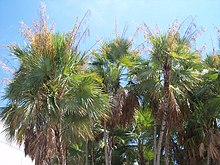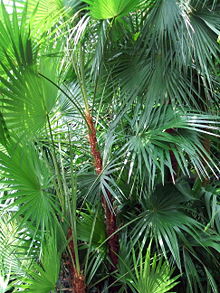| Acoelorraphe | |
|---|---|

| |
| Stand of fruiting specimens | |
| Conservation status | |
 Apparently Secure (NatureServe) | |
| Scientific classification | |
| Kingdom: | Plantae |
| Clade: | Tracheophytes |
| Clade: | Angiosperms |
| Clade: | Monocots |
| Clade: | Commelinids |
| Order: | Arecales |
| Family: | Arecaceae |
| Subfamily: | Coryphoideae |
| Tribe: | Trachycarpeae |
| Genus: | Acoelorraphe H.Wendl. |
| Species: | A. wrightii |
| Binomial name | |
| Acoelorraphe wrightii (Griseb. & H.Wendl.) H.Wendl. ex Becc. | |
| Synonyms | |
|
Of the genus:
Of the species:
| |
Acoelorraphe is a genus of palms with a single species Acoelorraphe wrightii, known as the Paurotis palm, Everglades palm or Madeira palm in English and cubas, tique, and papta in Spanish. The genus name is sometimes spelt as Acoelorrhaphe or Acoelorhaphe, which are treated as orthographical variants by the International Plant Names Index.
Description
It is a small to moderately tall palm that grows in clusters to 5–7 metres (16–23 ft), rarely 9 m (30 ft) tall, with slender stems less than 15 centimetres (5.9 in) diameter. The leaves are palmate (fan-shaped), with segments joined to each other for about half of their length, and are 1–2 m (3.3–6.6 ft) wide, light-green above, and silver underneath. The leaf petiole is 1–1.2 m (3.3–3.9 ft) long, and has orange, curved, sharp teeth along the edges. The flowers are minute, inconspicuous and greenish, with 6 stamens. The trunk is covered with fibrous matting. The fruit is pea-sized, starting orange and turning to black at maturity.
Taxonomy
The genus name is a combination of three Greek words meaning a- 'without', koilos 'hollow', and rhaphis 'needle', an allusion to the form of the fruit. The species is named after the American botanist Charles Wright.
Distribution and habitat
It is native to Central America, southeastern Mexico, the Caribbean, Colombia, the Bahamas, and extreme southern Florida where it grows close to sea level in thin, rocky soil over limestone in wet areas and swamps of the Everglades.
Cultivation and uses

The Paurotis palm was formerly plentiful in the Florida Everglades, but many plants were taken for the nursery trade. The palm is now protected in the wild by Florida law and its numbers are increasing again. Trees propagated from seed or by sawing apart the base of a cluster are available in nurseries. It is hardy to central and southern Florida and is cultivated as a landscape palm.
Gallery
References
- "NatureServe Explorer 2.0". explorer.natureserve.org. Retrieved 21 November 2022.
- H.A. Wendland Botanische Zeitung 37:148. 1879 Tpe:A. wrightii
- "Acoelorraphe H.Wendl." Plants of the World Online. Royal Botanic Gardens, Kew. Retrieved 2024-04-23.
- ^ "Acoelorraphe H.Wendl." International Plant Names Index (IPNI). Royal Botanic Gardens, Kew; Harvard University Herbaria & Libraries; Australian National Botanic Gardens. Retrieved 2024-04-23.
- "Acoelorraphe wrightii (Griseb. & H.Wendl.) H.Wendl. ex Becc." Plants of the World Online. Royal Botanic Gardens, Kew. Retrieved 2024-04-23.
- ^ World Checklist of Palms: Acoelorrhaphe Archived 2007-08-08 at the Wayback Machine
- Germplasm Resources Information Network: Acoelorrhaphe wrightii
- International Plant Names Index (IPNI): Acoelorrhaphe
- Palm & Cycad Societies of Florida: Acoelorrhaphe wrightii Archived 2006-07-02 at the Wayback Machine
- Villalobos, Nelson Zamora (2000). Arboles de la Mosquitia hondureña. Turrialba, Costa Rica: CATIE (Centro Agronómico Tropical de Investigación y Enseñanza). p. 5. ISBN 9789977573533.
- ^ Flora of North America: genus account and species account
- Huxley, A., ed. (1992). New RHS Dictionary of Gardening. Macmillan ISBN 0-333-47494-5.
- Grisebach, August H. R. (1866) Catalogus Plantarum Cubensium
- Bush, Charles S. and Morton, Julia F. (1969) Native Trees and Plants for Florida Landscaping (pp.11-12). Department of Agriculture - State of Florida.
| Taxon identifiers | |
|---|---|
| Acoelorraphe |
|
| Acoelorraphe wrightii |
|


